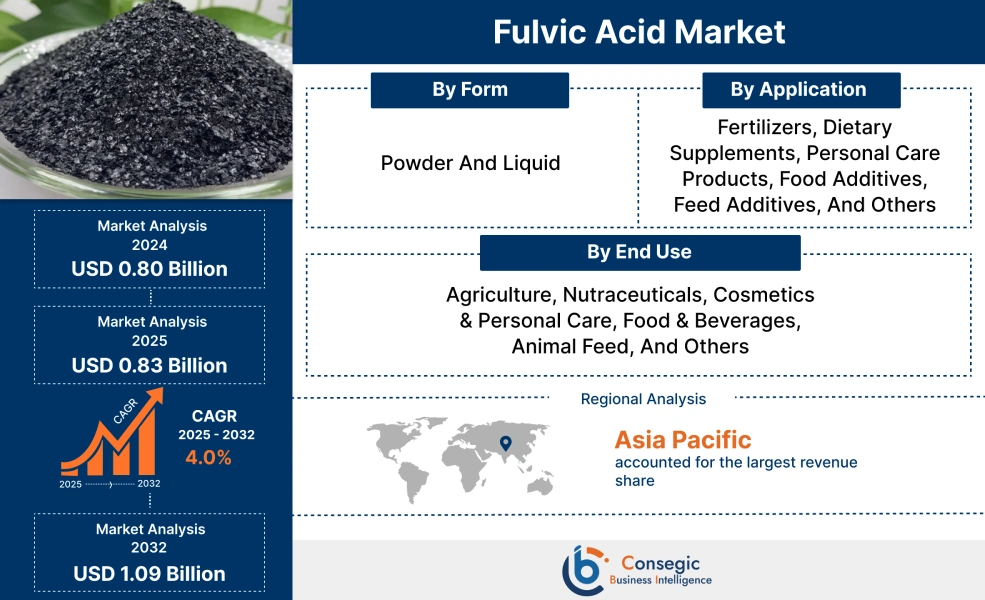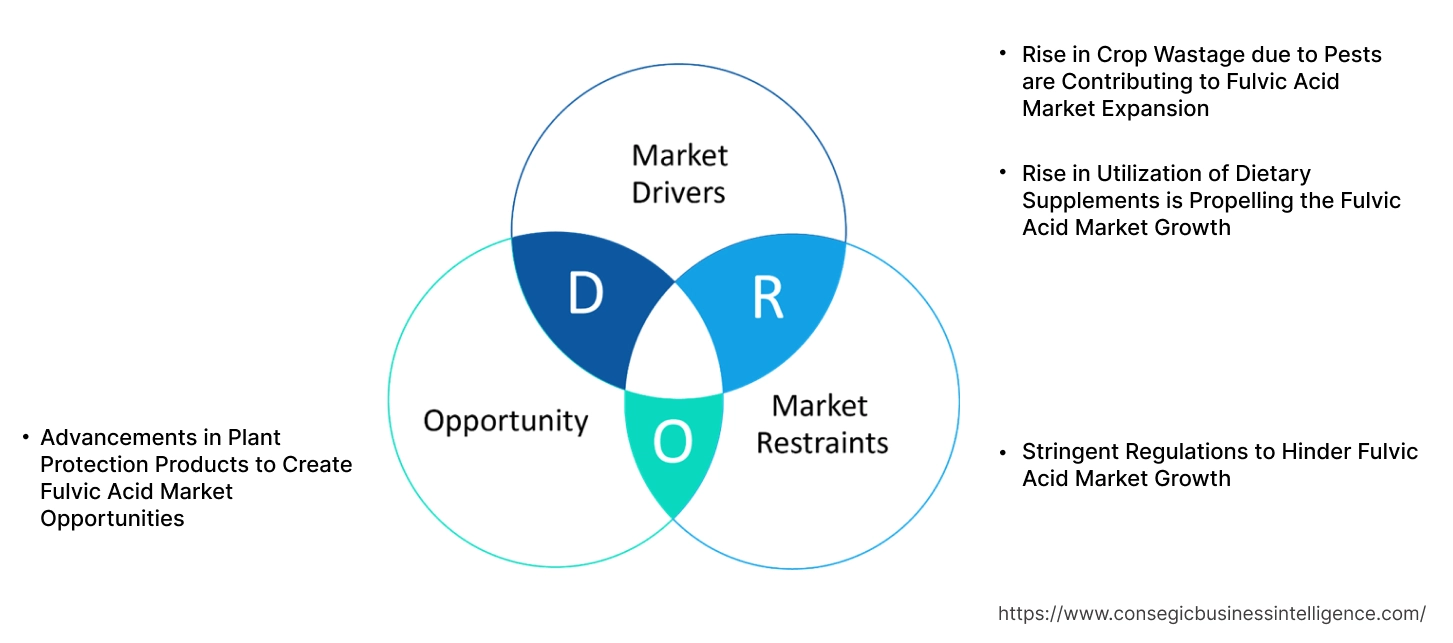Fulvic Acid Market Size:
The Fulvic Acid Market size is growing with a CAGR of 4.0% during the forecast period (2025-2032), and the market is projected to be valued at USD 1.09 Billion by 2032 from USD 0.80 Billion in 2024. Additionally, the market value for 2025 is attributed to USD 0.83 Billion.
Fulvic Acid Market Scope & Overview:
Fulvic Acid is a naturally occurring organic compound that generally is a complex mixture of various organic acids that is found in the humus. Humus is the dark, organic material formed in soil, peat, coal, and other natural environments through the decomposition of plant and animal matter by microorganisms. This acid is formed during the extensive breakdown and decomposition of organic materials over long periods, mediated by microbial activity. It is characterized by its relatively low molecular weight compared to humic acids, and its high solubility in water across a wide range of pH levels. This acid acts as a natural biological enhancer, accelerating the movement and utilization of essential nutrients and potentially helps in detoxification and protective functions in various biological systems.
How is AI Impacting the Fulvic Acid Market?
AI is significantly impacting the fulvic acid market by leveraging AI-powered soil analysis and crop monitoring systems help determine the exact amount and timing of fulvic acid application needed for optimal results. Additionally, AI-driven irrigation and fertigation systems can integrate with fulvic acid delivery, ensuring efficient nutrient absorption by crops. Moreover, AI-powered tools facilitate faster, and more accurate data analysis compared to traditional methods, providing a competitive edge. Further, AI-powered tools are enabling more precise soil analysis, optimized nutrient delivery, and customized product development, leading to increased efficiency and sustainability.
Fulvic Acid Market Dynamics - (DRO) :
Key Drivers:
Rise in Crop Wastage due to Pests are Contributing to Fulvic Acid Market Expansion.
The growing adoption of fulvic acid for combating diseases and pests is a pivotal factor driving the Fulvic Acid market expansion. This acid helps control diseases and pests in plants by enhancing plant health and resilience. It also acts as a chelator for improving nutrient uptake and stimulating plant growth, which makes plants less susceptible to diseases and pests. Additionally, foliar applications of this acid increase disease resistance and reduce insect infestations. Simultaneously, it minimizes collateral damage to beneficial insects and the corresponding environment.
- For instance, according to USDA’s National Institute of Food and Agriculture, wastage of global crop production on a yearly basis due to pest is between 20% - 40%.
As the agricultural advantages is increasingly recognized, the demand for advanced solutions for disease and pest control is expected to grow significantly.
Rise in Utilization of Dietary Supplements is Propelling the Fulvic Acid Market Growth.
The growing adoption of fulvic acid for combating diseases and pests is a pivotal factor driving the Fulvic Acid market expansion. This acid helps control diseases and pests in plants by enhancing plant health and resilience. It also acts as a chelator for improving nutrient uptake and stimulating plant growth, which makes plants less susceptible to diseases and pests. Additionally, foliar applications of this acid increase disease resistance and reduce insect infestations. Simultaneously, it minimizes collateral damage to beneficial insects and the corresponding environment.
- For instance, according to USDA’s National Institute of Food and Agriculture, wastage of global crop production on a yearly basis due to pest is between 20% - 40%.
As the agricultural advantages is increasingly recognized, the demand for advanced solutions for disease and pest control is expected to grow significantly.
Key Restraints:
Stringent Regulations to Hinder Fulvic Acid Market Growth.
Stringent regulations are important in order to ensure safety and environmental protection. Simultaneously, they also create hurdles for businesses involved in the development of innovative technologies. The process of obtaining regulatory approvals for novel agricultural technologies and fertilizer materials is time-consuming as well as expensive. It requires testing and thorough documentation. This lengthy approval process leads to delays in the market entry of innovative products. Furthermore, the dynamic nature of these regulations provides uncertainty and risk for businesses. This leads to discouraging investment in new technologies. This uncertainty hinders market entry. Moreover, stringent regulations also restrict the availability of certain technologies in specific markets, thereby limiting their widespread adoption and in turn hindering their commercial success.
Future Opportunities :
Advancements in Plant Protection Products to Create Fulvic Acid Market Opportunities.
The agricultural sector is witnessing a significant shift in plant protection strategies, moving away from sole reliance on synthetic chemical inputs towards more integrated, sustainable, and biologically enhanced solutions. This shift, which is driven by environmental concerns, regulatory pressures, and consumer requirement for healthier food, is creating potential for natural bio-stimulants like fulvic acid. Manufacturers are introducing novel plant protection products using this material.
For instance,
- In 2024, HGS BioScience, introduced two new fulvic acid solutions to their product line. The Ful-Grow MAX and Ful-Grow ULTRA are two new fulvic acid-based solutions specially formulated for foliar application as a nutritional adjuvant to defend against crop stress.
Thus, as per the market analysis, the advancements in plant protection products creates fulvic acid market opportunities.
Fulvic Acid Market Segmental Analysis :
By Form:
Based on form, the market is bifurcated into powder and liquid.
Trends in the Form:
- Development of easy-to-dissolve formulations to enhance user convenience
- Increased development of stable, long-shelf-life liquid formulations for various end-use applications.
The liquid segment accounted for the largest fulvic acid market share in 2024
- Liquid fulvic acid consists of fulvic acid dissolved in a liquid carrier such as water. It offers immediate usability with varying concentrations.
- The primary benefit of liquid formulation is its ease of application that makes it highly convenient for direct use via foliar sprays, drip irrigation systems, or hydroponics, ensuring rapid and uniform distribution.
- This dissolved form also facilitates quick absorption by plants through roots or foliage, and by the human body when consumed as a supplement.
- Consequently, its main applications include foliar sprays, integration into fertigation and hydroponic systems, and its common use in ready-to-use liquid dietary supplements due to perceived higher bioavailability.
- According to Interfax, the fertilizers production of Russia surpassed 63 million tonnes in 2024. This is approximately 6-7% a year-on-year increase.
- Thus, the aforementioned factors are influencing the fulvic acid market demand.
The powder segment is expected to grow at the fastest GAGR over the forecast period.
- Powdered fulvic acid available as a concentrated solid in granular or fine powder form boasts higher purity and potency per unit weight making it highly effective.
- Its primary advantages include superior ease of storage and transport due to its less bulky and lighter nature, which translates to reduced shipping costs and extended shelf life.
- Widely applied in agricultural uses like soil amendments and fertigation systems, it's also favored in horticulture and for precise small-scale farming.
- Furthermore, its concentrated and stable nature makes it the preferred choice for dietary supplements in capsule or tablet form, and for dry cosmetic formulations.
- Thus, the aforementioned factors are expected to boost the powder segment growth in the forecast years.
By Application:
Based on the application, the market is categorized into fertilizers, dietary supplements, personal care products, food additives, feed additives, and others.
Trends in the Application:
- Rising shift towards fulvic acid-based foliar sprays for rapid nutrient uptake and stress resilience in crops is a key fulvic acid market trend.
- Development of combination supplements incorporating fulvic acid with minerals, vitamins, or probiotics for synergistic effects is a trend positively impacting the market.
The fertilizers segment accounted for the fulvic acid market share of 54.19% in 2024.
- In fertilizers, fulvic acid is widely utilized as direct soil amendment, foliar spray, or ingredient in fertilizer formulations.
- It significantly enhances nutrient uptake efficiency by celebrating vital minerals, thereby boosting their bioavailability to plants.
- Beyond nutrient delivery, it actively improves soil structure, enhances water retention capabilities, and stimulates beneficial microbial activity, collectively fostering healthier soils and driving substantial increases in crop yields and quality.
- Escalating global shift towards sustainable and organic farming, a growing necessity for natural and bio-based crop inputs, and a critical focus on optimizing nutrient use efficiency are the key factors influencing the segment revenue.
- For instance, in 2023, Bionema Group Ltd, launched seven new biostimulant products in the UK, including fulvic substances for agriculture, horticulture, forestry, and turf.
- As a result, as per the fulvic acid market analysis, the fertilizers segment is influencing market development.
The dietary supplements segment is expected to grow at the fastest CAGR over the forecast period.
- Fulvic acid has emerged as a popular ingredient within health and wellness products, commonly appearing in capsules, powders, and liquid supplement formulations.
- It is actively marketed for its potential to boost nutrient absorption, function as an antioxidant, bolster immune responses, foster gut health, and assist in detoxification processes, frequently being combined with trace minerals.
- This segment's growth is primarily fueled by increasing consumer awareness and a strong preference for natural and holistic health solutions along with rising interest in gut health and microbiome support.
- The requirement for dietary supplements that improve the bioavailability of other nutrients further propels its segment revenue.
- Hence, as per analysis, agrochemicals segment is growing at fastest rate in the upcoming years.
By End Use:
Based on the End Use, the market is categorized into agriculture, nutraceuticals, cosmetics & personal care, food & beverages, animal feed, and others.
Trends in the End Use:
- Increasing integration into precision agriculture techniques for optimized nutrient delivery and resource efficiency is a key trend.
- Growing adoption in gut health and immune support formulations catering to increased consumer interest in holistic wellness.
The agriculture segment accounted for the market share in 2024.
- In the agricultural industry, fulvic acid is extensively employed as a natural biostimulant, soil conditioner, and nutrient enhancer.
- Widely incorporated into various agricultural inputs such as granular and liquid fertilizers, foliar sprays, seed treatments, and root drench applications, it significantly improves the efficiency of essential minerals by plants.
- Furthermore, it enhances soil structure, boosts water retention, and stimulates beneficial microbial activity, ultimately leading to healthier crops and increased yields.
- This segment's revenue is driven by the global shift towards organic farming and sustainable agricultural practices along with increasing requirement for natural and bio-based crop inputs.
- Hence, as per analysis, the agriculture segment is influencing the overall requirement of the market.
The nutraceuticals segment is expected to grow at the fastest GAGR in the forecast period.
- In nutraceuticals, fulvic acid serves as crucial ingredient in diverse health and wellness products, including dietary.
- It presents potential to enhance nutrient absorption, act as an antioxidant, support immune function, improve gut health, and assist in cellular detoxification, often appearing alongside trace minerals.
- This segment's robust growth is propelled by increasing consumer awareness and a strong preference for natural and holistic health solutions.
- For instance, in 2025, Steadfast Nutrition launched SteadShilajit Gold, a new supplement containing 75% fulvic acid, aligning with the growing trend of traditional medicine-inspired formulations in India's nutraceutical industry.
- As a result, the aforementioned factors are expected to fuel segment development in the upcoming years.
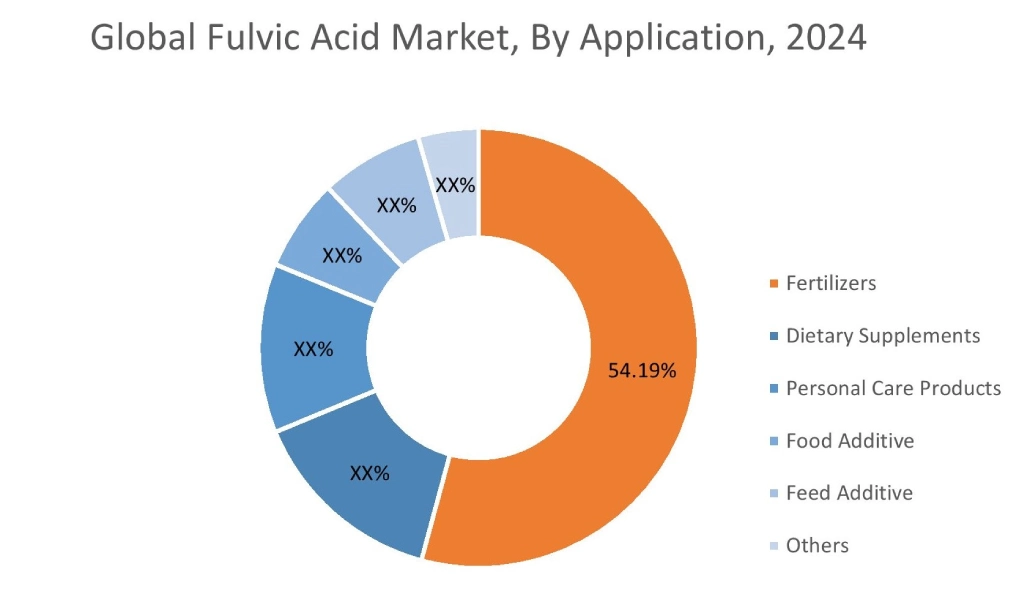
Regional Analysis:
The regional segment includes North America, Europe, Asia Pacific, the Middle East and Africa, and Latin America.
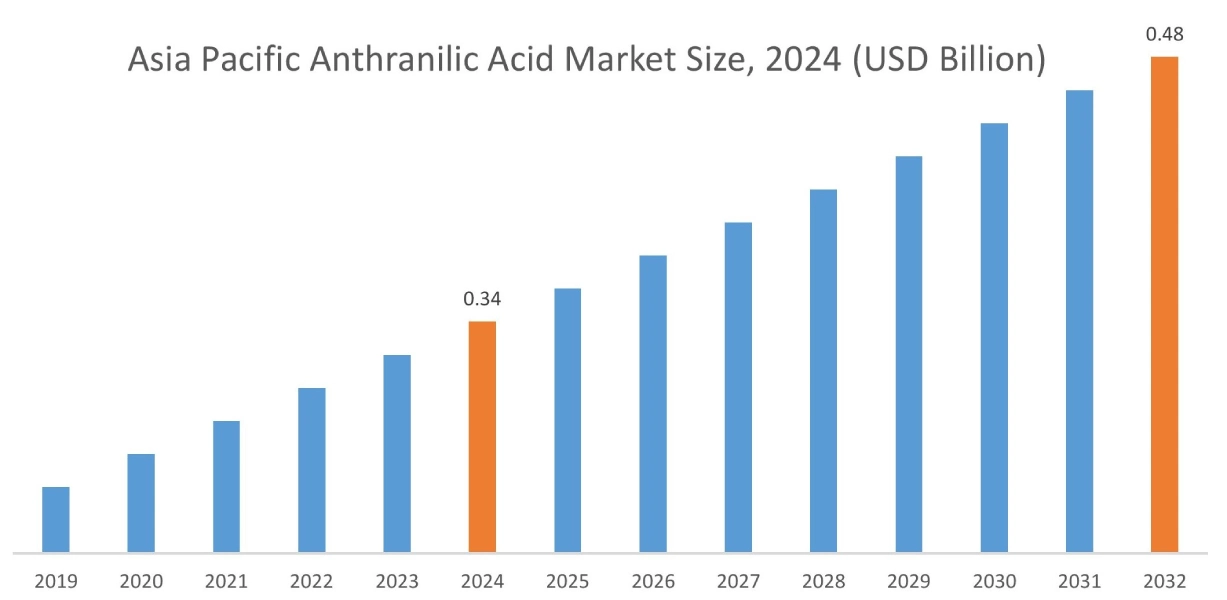
In 2024, Asia Pacific accounted for the highest market share at 42.38% and was valued at USD 0.34 Billion and is expected to reach USD 0.48 Billion in 2032. In Asia Pacific, China accounted for a market share of 40.06% during the base year of 2024. The market for fulvic acid in the Asia Pacific region is significantly defined by the region being both the major producer as well as consumer of fulvic acid. Countries like China and India, with their large populations, face increasing food demands, driving a strong emphasis on maximizing crop yields and improving soil health. This acid is experiencing significant adoption as a key component in fertilizers due to its ability to enhance nutrient uptake, improve soil structure, and boost crop resilience. The region's growing shift towards organic farming practices and a heightened awareness of sustainable agricultural inputs further accelerates the requirement for fulvic acid-based fertilizers.
- For instance, the Ministry of Agriculture and Farmers Welfare in India has amended the Fertilizer Control Order, 1985, through the 2025 Fourth Amendment Order, introducing comprehensive regulations and detailed specifications for biostimulants like fulvic acid to enhance crop productivity and promote sustainable farming.
Collectively, the aforementioned factors position Asia Pacific as a significant market for the compound.
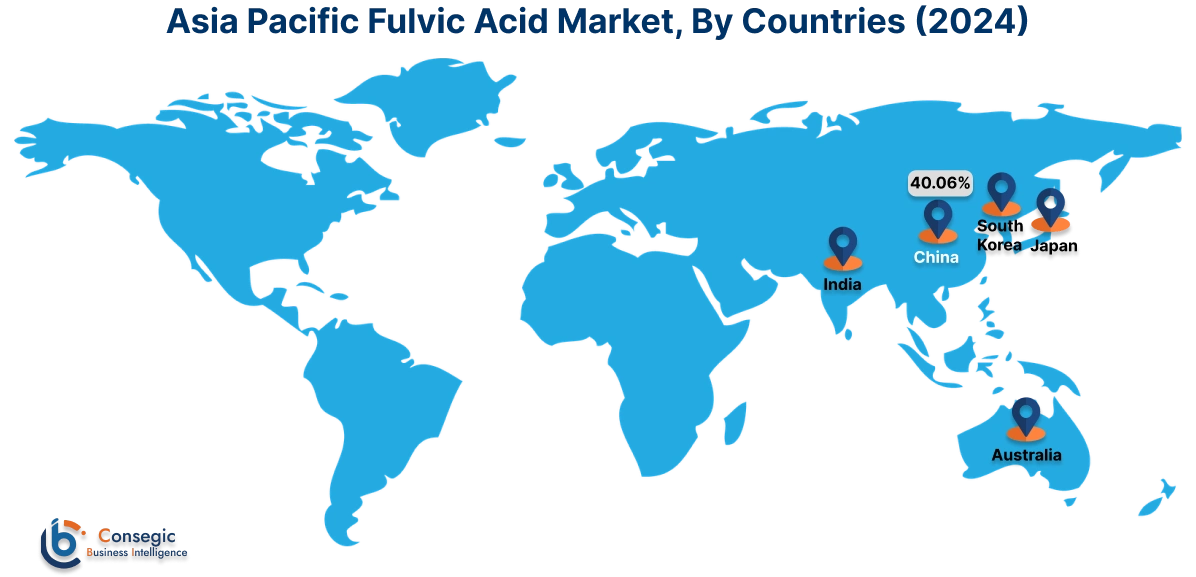
In Europe, the Fulvic Acid industry is experiencing the fastest growth with a CAGR of 7.5% over the forecast period owing to the advancements in plant protection products and the region's strong commitment to organic and sustainable farming. European farmers are increasingly adopting fulvic acid due to its efficacy as a natural biostimulant, enhancing plant resilience and nutrient uptake while reducing reliance on synthetic chemicals. The demand for integrated pest management and environmentally friendly agricultural solutions is pushing manufacturers to incorporate it into innovative plant protection formulations. This aligns perfectly with the rising consumer and regulatory preference for organic produce and sustainable practices across the continent. This strategic shift is creating new avenues for the market within Europe's advanced chemical sector.
In North America market analysis is propelled by the robust development within its dietary supplements and nutraceuticals sector. Consumers in the region are increasingly prioritizing natural and holistic health solutions, driving a strong demand for supplements that promise enhanced well-being. Fulvic acid is a key ingredient in these supplements, marketed for its potential to improve nutrient absorption, support immune function, and promote gut health, often appearing alongside trace minerals. This rising consumer awareness of natural health benefits, coupled with a growing interest in microbiome support and anti-aging solutions, is directly fueling the market's development as more health and wellness brands incorporate fulvic acid into their product offerings across North America.
The Latin American pharmaceutical market is experiencing substantial development, mainly because of factors such as growing increasing healthcare expenditure, and a rising prevalence of chronic diseases. This growth leads to a growing requirement for various active pharmaceutical ingredients (APIs) and excipients, including those derived from natural sources. Fulvic acid provides health benefits such as anti-inflammatory, antioxidant, immune-modulating, and nutrient-absorption enhancing properties, which are in nutraceuticals, and even some medicinal formulations. Thus, as per the fulvic acid market analysis, the rise in the need for effective pharmaceuticals is driving the fulvic acid market trends in this region.
The rapidly expanding market for cosmetic and personal care products in the Middle East and Africa region is proving to be a significant catalyst for market expansion. This rise in the requirement for beauty and wellness products in this region is driven by factors such as increasing disposable incomes, a growing young and fashion-conscious population, and growing awareness of global beauty trends through social media and e-commerce. Natural solutions such as fulvic acid are gaining significance as a powerful ingredient in skincare, haircare, and other personal care products due to its numerous beneficial properties. Thus, as per the market analysis the rise in the requirement for personal care and cosmetic products is influencing the use of this acid in the Middle East and Africa region.
Top Key Players and Market Share Insights:
The Global Fulvic Acid Market is highly competitive with major players providing products to the national and international markets. Key players are adopting several strategies in research and development (R&D) and product innovation to hold a strong position in the global Fulvic Acid market. Key players in the Fulvic Acid industry include:
- HGS Bioscience (U.S.)
- Peptech Biosciences Ltd. (India)
- Zhengzhou Shengda khumic biotechnology Co., Ltd. (China)
- Omnia Specialities Pty (Australia)
- Live Earth Products, Inc. (U.S.)
- Valagro (Italy)
- Biolchim SPA (Italy)
- SAINT HUMIC ACID (China)
- AgTonik, LLC (U.S.)
Fulvic Acid Market Report Insights :
| Report Attributes | Report Details |
| Study Timeline | 2019-2032 |
| Market Size in 2032 | USD 1.09 Billion |
| CAGR (2025-2032) | 4.0% |
| By Form |
|
| By Application |
|
| By End Use |
|
| By Region |
|
| Key Players |
|
| North America | U.S. Canada Mexico |
| Europe | U.K. Germany France Spain Italy Russia Benelux Rest of Europe |
| APAC | China South Korea Japan India Australia ASEAN Rest of Asia-Pacific |
| Middle East and Africa | GCC Turkey South Africa Rest of MEA |
| LATAM | Brazil Argentina Chile Rest of LATAM |
| Report Coverage |
|
Key Questions Answered in the Report
How big is the Fulvic Acid market? +
In 2024, the Fulvic Acid market is USD 0.80 Billion.
Which is the fastest-growing region in the Fulvic Acid market? +
Europe is the fastest-growing region in the Fulvic Acid market.
What specific segmentation details are covered in the Fulvic Acid market? +
By Form, Application and End Use segmentation details are covered in the Fulvic Acid market.
Who are the major players in the Fulvic Acid market? +
HGS Bioscience (U.S.), Valagro (Italy), Biolchim SPA (Italy) are some of the major players in the market.
